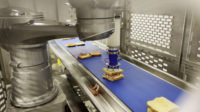CASE STUDY
Frozen Potato Processor Automates Inline Inspection Machine Tests

Halo tests three metal samples - ferrous, non-ferrous, and stainless steel – and performs the verification tests aligned to each product SKU on the fly. Courtesy Fortress Technology.
As one of the largest suppliers of frozen retail, wholesale and foodservice potato products, and with a strong global clientele, automation and state-of-the-art technology features strongly at the firm’s multiple potato processing plants.
Alongside scales, shakers, vibrators, graders, baggers, open bag detectors, case packers, sortation conveyors, palletizers and wrappers, located towards the end of multiple processing lines are several dozen highly-sensitive Stealth metal detectors. Each supplied with Fortress customized reject conveyors.
Every metal detector is equipped with Fortress Technology’s Halo Automatic Testing to perform a total of 180 hourly quality control tests on multiple product SKUs. Fortress also designed an ultra-secure reject system. The engineering of added safeguards to quarantine metal-contaminated products prevents contaminated products from being reintroduced to the line.
Testing the performance of conveyor metal detectors is typically done manually. However, the challenge for an operation of this magnitude is conforming to multiple QC testing criteria set by suppliers and switching between multiple product SKUs. In this instance, the frozen products range from smaller consumer-sized bags weighing from a half-pound, to restaurant-sized bulk packaged bags of French fries exceeding 20 pounds.
For this processor, several customer QC testing standards stipulated that all three metal samples, ferrous, non-ferrous and stainless steel, be tested in three different but very exact product positions as the bags of frozen potato products pass through the centre of the metal detector aperture. However, performing up to 180 manual tests hourly across multiple high-speed processing lines manually and checking the performance of the reject system would be extremely labor intensive, disruptive to production and damage good product. Leading to potentially high product wastage and costly production losses due to downtime.
Rather than being reliant on QC technicians to perform, document and submit these repeatable inspection tests, Fortress presented a strong business case to adopt its Halo Automatic Testing solution. Over two dozen systems were shipped to the company’s processing plants in two phases over the last decade.
Halo enables the frozen potato processor to program and conform to every customer’s performance verification testing program. Including independently testing all three metals in the leading, trailing and middle of product bags every hour.
Mimicking the disturbance caused by a test contaminant calibrated to the precise size, metal type and speed that product bags pass through the metal detector aperture – up to 150ppm for this potato processor – results in substantial labor savings. It also significantly improves the quality and accuracy of every test, said Fortress Regional Sales Manager Eric Garr.
“The metal detector pulls in data from the infeed photo sensor to determine when Halo must trigger and introduce the simulated test sample in the leading edge, trailing edge and middle of the bag,” he said.
This is always programmed to be in the exact geometric center of the aperture to robustly challenge the performance of the metal detector. A process that can be extremely challenging to efficiently perform manually.
The requirement to perform leading, middle and trailing edge performance verifications was specifically requested by a fast food chain customer. ‘Product effect’ is the main rationale. Bulky frozen products weighing up to 20 lbs. could result in high levels of false rejects. This not only distorts results but also could lead to potentially high volumes of good product being wasted.
“By testing all three metals in three positions ensures the metal samples are not being masked by the product in any position and also confirms that the reject system is tracking correctly. This is especially important in frozen bulk products when the characteristics might change due to slight thawing during the inspection phase,” Garr said.
Switching and adapting to different test routines is equally straightforward. This means that for customers whose standards only require one pass of each metal sample every hour, the infeed sensor picks this up and communicates with Halo to perform the verification tests aligned to each product SKU.
Each production line will only halt if the metal detector performance test or reject check fails. To assist with audit traceability, each individual metal detector automatically logs all the data from each test, which can be extracted by USB and reviewed using Contact Reporter software. Providing a reliable machine performance and due diligence audit trail.
Several extra failsafe features were added by Fortress to ensure quarantined rejected products are never reintroduced to the processing line. This includes equipping each reject bin with magnetic locks and issuing controlled security card access to authorized personnel only.
With any products rejected during the Halo test, the reject bin automatically unlocks enabling personnel to move the bags back upstream to be re-inspected. However, to distinguish between a genuine contaminant rejection and product isolated during the Halo performance verification test, the metal detector bin door automatically remains locked if a reject was already present.
When used as prescribed, the operational savings can be huge. For this specific processing plant, the combination of eliminating human errors, eradicating workforce safety risks, labor savings and reducing product waste, means Fortress moderately estimates a payback of less than several months on the original investment. Meaning that each Stealth Metal Detector equipped with Halo has potentially paid for itself more than 30 times over already.
Looking for a reprint of this article?
From high-res PDFs to custom plaques, order your copy today!



-11.jpg?height=200&t=1680037048&width=200)

